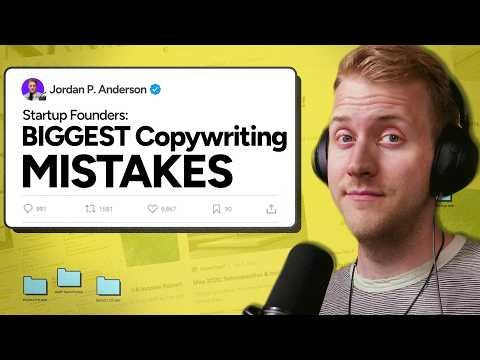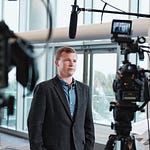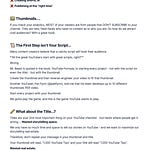Hey there,
Jordan P. Anderson here again.
The 5-second test that makes or breaks your sales page...
Let’s be honest: your sales page isn’t living up to its potential.
But don’t worry – we’re going to fix that.
Here’s the unvarnished truth about sales pages: They’re not about fancy design or clever wordplay. They’re about one thing: converting visitors into customers. Every element on your page should serve this singular purpose. If it doesn’t, it needs to go.
Let’s break down the key elements of a high-converting sales page and see where you might be falling short.
1. Your Hero Section Needs a Makeover
You’ve got 5 seconds to make an impression.
That’s it.
In those crucial moments, you need to grab attention, spark interest, and compel the visitor to keep scrolling. Most founders miss the mark here. They use vague, uninspiring headlines like “Grow Your Business” or “Innovate Your Workflow.” These generic phrases do nothing to differentiate you or create urgency.
Instead, hit them with specificity and a clear value proposition: “Get Your First 1,000 Customers In 10 Days.”
This headline does three things at once: it targets a specific audience (new businesses), offers a concrete benefit (1,000 customers), and provides a timeframe (10 days).
It’s specific, measurable, and compelling.
That’s the difference between a headline that makes someone yawn and one that makes them want to know more.
2. Prove Your Worth Before You Pitch
Here’s a hard pill to swallow: at this stage, nobody knows who you are.
Your startup? It’s just another name in a sea of companies vying for attention. Trust?
You haven’t earned it yet. So before you start waxing poetic about your amazing features, you need to prove you can deliver results.
How do you do this?
Start with real testimonials, and don’t just use a name and a quote.
Link to LinkedIn profiles or company websites. This adds a layer of credibility and shows these are real people with real opinions. Next, showcase specific results.
Instead of saying “We’ve helped many startups,” say “We’ve helped startups earn $594,500 in launch revenue.” The specificity here is key – it’s concrete, impressive, and believable.
Finally, display logos of companies your customers have worked with. This associative credibility can go a long way in building trust quickly.
Remember: Build trust first, then sell. Without trust, even the best features in the world won’t convince anyone to buy.
3. Get Personal with Your Problem Statement
“Are you struggling to grow your business?”
This kind of generic problem statement is the fastest way to lose your reader’s interest.
Every business struggles with growth. You need to get specific, get personal, and show that you truly understand your target customer’s unique challenges.
Try this instead: “You’re a startup founder with a product you believe in.
But you haven’t launched yet because: 1) You’re overwhelmed by conflicting advice and have no clear starting point, 2) Despite your expertise in your field, you feel like an impostor in the world of marketing and sales, 3) You’re terrified that after all your hard work, no one will buy.” This problem statement speaks directly to the emotional and practical challenges of your target audience.
It shows you understand their specific situation, which makes them more likely to believe you have the solution.
4. Your Solution Should Paint a Picture of Success
Features are important, but benefits are everything. Don’t just tell me what your product does – show me how it’s going to transform my business and my life.
Instead of “Our course has 6 modules and 20 video lessons,” try “In just 4 weeks, you’ll go from ‘stuck’ to ‘launched,’ with a step-by-step plan that eliminates guesswork and leads you to your first 1,000 customers.”
This approach does more than list features – it paints a picture of the transformation.
It addresses the problems you outlined earlier (feeling stuck, not knowing where to start) and provides a clear, tangible outcome (launched with 1,000 customers). When describing your solution, always tie it back to the problems and desired outcomes you’ve identified.
This creates a narrative that your potential customers can see themselves in.
5. Use Bonuses Strategically
Bonuses aren’t just nice-to-haves or afterthoughts.
They’re strategic tools to sweeten the deal and overcome lingering objections. Each bonus should serve a purpose – whether it’s adding extra value, addressing a specific pain point, or overcoming a common objection.
For example: “Bonus: Access to our private Slack channel where successful founders share their launch strategies and offer peer support (Value: $997/year).”
This bonus addresses multiple needs: it provides ongoing support, offers a community (addressing the feeling of being alone in the journey), and gives access to proven strategies from peers.
When crafting your bonuses, think about what else your customer needs to succeed, and how you can provide that in a high-value, low-cost (to you) way.
6. Anticipate and Crush Objections
Every potential customer has objections.
Your job is to anticipate and address each one before it becomes a roadblock to purchase. Common objections include concerns about price, time investment, and effectiveness.
Use price anchoring to address cost concerns: “Most startups spend upwards of $50,000 on their launch, hiring separate experts for strategy, copywriting, and ads. Our comprehensive program gives you all of this for a fraction of the cost.”
This puts your pricing in perspective and highlights the value you’re offering.
For those worried about time investment, emphasize the efficiency of your solution: “Our streamlined process takes just 3 hours a week. We’ve distilled years of expertise into a focused system that respects your time while delivering results.”
Address effectiveness concerns with a strong guarantee: “Test drive everything for 90 days.
If you don’t see measurable progress towards your launch goals, we’ll refund every penny. No questions asked.” A guarantee like this shows confidence in your product and removes the risk for the buyer.
7. Close with Confidence and Clarity
The end of your sales page is not the time for subtlety.
It’s time to bring together everything you’ve presented and make a clear, compelling case for action.
Recap everything they’re getting – your core offer, all the bonuses, the guarantee.
Paint a vivid picture of success: “A year from now, you could be celebrating your successful launch, watching your customer base grow, and finally seeing the fruits of your hard work.
Or you could still be stuck in the same place, watching competitors pass you by, wondering ‘what if.’”
Then, hit them with a clear, impossible-to-miss call-to-action. Make it big, make it bold, and make it benefit-driven: “Click Here to Launch Your Startup and Get Your First 1,000 Customers in 10 Days.”
Creating a high-converting sales page isn’t about tricks or gimmicks. It’s about deeply understanding your customer, clearly communicating your value, and systematically removing every obstacle to purchase. It’s about creating a narrative that resonates and a offer that’s impossible to refuse.
Now, armed with these insights, it’s time to transform your sales page from an underperformer to a conversion powerhouse. Your future customers are waiting.
Cheers,
Jordan P. Anderson
















The 5-second test that makes or breaks your sales page...